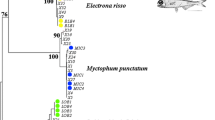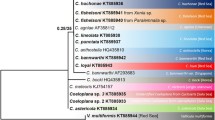Abstract
Acila divaricata (Hinds, 1843) and A. mirabilis (Adams and Reeve, 1850) are common benthic bivalves in China. A number of researchers have proposed that the latter species is a junior synonym of the former species. Because of morphological similarities, it is difficult to distinguish these two species based on visual examination only. For better understanding of their taxonomy, the mitochondrial COI gene fragments of five individuals of A. divaricata from the East China Sea and six individuals of A. mirabilis from the Yellow Sea were sequenced in this study. The phylogenetic relationships of the obtained COI sequences, together with nineteen sequences of three species of the genus Nucula, were analyzed. The pairwise intra- and inter-specific distances for the COI sequences ranged from 0.002 to 0.017 and from 0.128 to 0.134, respectively, and no overlap was found. Phylogenetically, A. divaricata and A. mirabilis form distinct clades and cluster into a sister to all other Nucula species. The results indicated that A. divaricata and A. mirabilis are two distinct species. The differences in the morphology and distribution between the two species were briefly discussed.
Similar content being viewed by others
References
Adams, A., and Reeve, L., 1850. Mollusca. In: The Zoology of the Voyage of H.M.S. Samarang: under the Command of Captain Sir Edward Belcher, C. B., F. R. A. S., F. G. S., During the Years 1843-1846. Adams, A., ed., Reeve and Benham, London, 1–87.
Avise, J. C., and Johns, G. C., 1999. Proposal for a standardized temporal scheme of biological classification for extant species. Proceedings of the National Academy of Sciences, 96(13): 7358–7363.
Bernard, F. R., Cai, Y. Y., and Morton, B., 1993. Catalogue of the Living Marine Bivalve Molluscs of China. Hong Kong University Press, Hong Kong, 146pp.
Blaxter, M., 2003. Molecular systematics: Counting angels with DNA. Nature, 421(6919): 122–124.
Blaxter, M., 2004. The promise of a DNA taxonomy. Philo-sophical Transactions of the Royal Society of London. Series B: Biological Sciences, 359(1444): 669.
Dall, W. H., 1898. Contributions to the Tertiary fauna of Florida, with especial reference to the silex-beds of Tampa, and the Pliocene beds of the Caloosahatchie River, indluding in many cases a complete revision of the generic groups treated of and their American Tertiary species. Part IV. 1. Prionodesmacea: Nucula to Julia. 2. Teleodesmacea: Teredo to Ervila. Trans-actions of the Wagner Free Institute of Science of Phila-delphia, 3(4): 571–947.
Felsenstein, J., 1985. Confidence limits on phylogenies: an approach using the bootstrap. Evolution, 39(4): 783–791.
Folmer, O., Black, M., Hoeh, W., Lutz, R., and Vrijenhoek, R., 1994. DNA primers for amplification of mitochondrial cytochrome c oxidase subunit I from diverse metazoan invertebrates. Molecular Marine Biology and Biotechnology, 3(5): 294–299.
Galtier, N., Nabholz, B., Glémin, S., and Hurst, G. D. D., 2009. Mitochondrial DNA as a marker of molecular diversity: A reappraisal. Molecular Ecology, 18(22): 4541–4550.
Gérard, K., Bierne, N., Borsa, P., Chenuil, A., and Féral, J.-P., 2008. Pleistocene separation of mitochondrial lineages of Mytilus spp. mussels from Northern and Southern Hemispheres and strong genetic differentiation among southern populations. Molecular Phylogenetics and Evolution, 49(1): 84–91.
Glover, E. A., Taylor, J. D., and Williams, S. T., 2008. Mangrove associated lucinid bivalves of the central Indo-West Pacific: Review of the ‘Austriella’ group with a new genus and species (Mollusca: Bivalvia: Lucinidae). Raffles Bulletin of Zoology, Supplement, 18: 25–40.
Godfray, H. C. J., 2002. Challenges for taxonomy. Nature, 417(6884): 17–19.
Habe, T., 1958. Report on the Mollusca chiefly collected by the S.S. Soyo-Maru of the Imperial Fisheries Experimental Station on the continental shelf bordering Japan during the years 1922–1930. Part 3. Lamellibranchia (1). Publications of the Seto Marine Biological Laboratory, 6(3): 241–280.
Habe, T., 1977. Systematics of Mollusca in Japan: Bivalvia and Scaphopoda. Hokuryukan Publishing Co., Tokyo, 372pp.
Hall, T. A., 1999. BioEdit: A user-friendly biological sequence alignment editor and analysis program for Windows 95/98/NT. Nucleic Acids Symposium Series, 41: 95–98.
Hanley, S. C. T., 1860. Monograph of the family Nuculidae, forming the Lamarckian genus Nucula. In: Thesaurus Conchyliorum or Monographs of Genera of Shells, Vol. 3. Sowerby, II G. B. ed., London, 105–168.
Hebert, P. D. N., Cywinska, A., Ball, S. L., and de Waard, J. R., 2003. Biological identifications through DNA barcodes. Proceedings of the Royal Society of London. Series B: Biological Sciences, 270(1512): 313–321.
Hebert, P. D. N., and Gregory, T. R., 2005. The promise of DNA barcoding for taxonomy. Systematic Biology, 54(5): 852–859.
Hebert, P. D. N., Penton, E. H., Burns, J. M., Janzen, D. H., and Hallwachs, W., 2004. Ten species in one: DNA barcoding reveals cryptic species in the neotropical skipper butterfly Astraptes fulgerator. Proceedings of the National Academy of Sciences of the United States of America, 101(41): 14812–14817.
Hickerson, M. J., Meyer, C. P., and Moritz, C., 2006. DNA barcoding will often fail to discover new animal species over broad parameter space. Systematic Biology, 55(5): 729–739.
Hinds, R. B., 1843. Descriptions of new species of Nucula, from the collections of Sir Edward Belcher, C. B., and Hugh Cuming, Esq. Proceedings of the Zoological Society of London, 11: 97–101.
Huber, M., 2010. Compendium of Bivalves. ConchBooks, Hackenheim, 901pp.
Kilburn, R. N., 1999. The family Nuculidae (Bivalvia: Protobranchia) in South Africa and Mozambique. Annals of the Natal Museum, 40: 245–268.
Kimura, M., 1980. A simple method for estimating evolutionary rates of base substitutions through comparative studies of nucleotide sequences. Journal of Molecular Evolution, 16(2): 111–120.
Knudsen, J., 1967. The deep-sea Bivalvia. Scientific Reports of The John Murray Expedition, 1933-34, 11(3): 237–343.
Kuroda, T., and Habe, T., 1981. A Catalogue of Molluscs of Wakayama Prefecture, the Province of Kii: I. Bivalvia, Scaphopoda and Cephalopoda. Nakanishi Printing Co., Ltd, Kyoto, 301pp.
Ladhar-Chaabouni, R., Hamza-Chaffai, A., Hardivillier, Y., Chénais, B., and Denis, F., 2010. A pilot study of genetic differentiation between two phenotypes of a Mediterranean population of the bivalve Cerastoderma glaucum and genetic discrimination with other Cerastoderma glaucum and Cerastoderma edule populations outside the Mediterranean. Marine Ecology, 31(2): 355–363.
Lan, T. C., 2001. Report on Taiwan Protobranchia. The Pei-yo, 27: 37–49.
Lipscomb, D., Platnick, N., and Wheeler, Q., 2003. The intellectual content of taxonomy: A comment on DNA taxonomy. Trends in Ecology and Evolution, 18(2): 65–66.
Liu, R. Y., 2008. Checklist of Marine Biota of China Sea. Science Press, Beijing, 1267pp.
Liu, R. Y., and Xu, F. S., 1963. Preliminary study on the benthic fauna of the Yellow Sea and the East China Sea. Oceanologia et Limnologia Sinica, 5(4): 306–321.
Lutaenko, K. A., and Noseworthy, R. G., 2012. Catalogue of the. Living Bivalvia of the Continental Coast of the Sea of Japan (East Sea). Dalnauka, Vladivostok, 247pp.
Mikkelsen, N. T., Schander, C., and Willassen, E., 2007. Local scale DNA barcoding of bivalves (Mollusca): A case study. Zoologica Scripta, 36(5): 455–463.
Moore, W. S., 1995. Inferring phylogenies from mtDNA variation: mitochondrial-gene trees versus nuclear-gene trees. Evolution, 49(4): 718–726.
Moritz, C., and Cicero, C., 2004. DNA barcoding: Promise and pitfalls. Plos Biology, 2(10): 1529–1531.
Okutani, T., 2000. Marine Mollusks in Japan. Tokai University Press, Tokyo, 1173pp.
Pennisi, E., 2003. Modernizing the Tree of Life. Science, 300(5626): 1692–1697.
Qi, Z. Y., 2004. Seashells of China. China Ocean Press, Beijing, 418pp.
Radulovici, A. E., Archambault, P., and Dufresne, F., 2010. DNA barcodes for marine biodiversity: Moving fast forward?. Diversity, 2(4): 450–472.
Rubinoff, D., Cameron, S., and Will, K., 2006. A genomic perspective on the shortcomings of mitochondrial DNA for ‘Barcoding’ identification. Journal of Heredity, 97(6): 581–594.
Saitou, N., and Nei, M., 1987. The neighbor-joining method: a new method for reconstructing phylogenetic trees. Molecular Biology and Evolution, 4(4): 406–425.
Sambrook, J., and Russell, D. W., 2006. The Condensed Protocols from Molecular Cloning: A Laboratory Manual. Cold Spring Harbor Laboratory Press, 800pp.
Schenck, H. G., 1934. Classification of nuculid pelecypods. Bulletin du Musée royal d’Histoire Naturelle de Belgique, 10(20): 1–78.
Schenck, H. G., 1935. Valid Species of the Nuculid Pelecypod Acila. Bulletin du Musée Royal d’Histoire Naturelle de Belgique, 11(14): 1–5.
Schenck, H. G., 1936. Nuculid bivalves of the genus Acila. Geological Society of America Special Papers, 4: 1–149.
Smith, E. A., 1892. Descritpions of new species of Nucula, and a list of the species belonging to the subgenus Acila. Journal of Conchology, 7: 110–112.
Sowerby II, G. B., 1871. Monograph of the genus Nucula. In: Conchologia Iconica: Or Illustrations of the Molluscous Animals, Vol. 18. Reeve, B., ed., London.
Stoeckle, M., 2003. Taxonomy, DNA, and the bar code of life. Bioscience, 53(9): 796–797.
Tamura, K., Peterson, D., Peterson, N., Stecher, G., Nei, M., and Kumar, S., 2011. MEGA5: Molecular evolutionary genetics analysis using maximum likelihood, evolutionary distance, and maximum parsimony methods. Molecular Biology and Evolution, 28(10): 2731–2739.
Tautz, D., Arctander, P., Minelli, A., Thomas, R., and Vogler, A., 2002. DNA points the way ahead in taxonomy. Nature, 418(6897): 479–479.
Tautz, D., Arctander, P., Minelli, A., Thomas, R. H., and Vogler, A. P., 2003. A plea for DNA taxonomy. Trends in Ecology and Evolution, 18(2): 70–74.
Tchang, S., Tsi, C. Y., Zhang, F. S., and Ma, S. T., 1963. A preliminary study of the demarcation of marine molluscan faunal regions of China and its adjacent waters. Oceanologia et Limnologia Sinica, 5(2): 124–138.
Vitousek, P. M., Mooney, H. A., Lubchenco, J., and Melillo, J. M., 1997. Human domination of earth’s ecosystems. Science, 277(5325): 494–499.
Will, K. W., and Rubinoff, D., 2004. Myth of the molecule: DNA barcodes for species cannot replace morphology for identification and classification. Cladistics, 20(1): 47–55.
Will, K. W., Mishler, B. D., and Wheeler, Q. D., 2005. The perils of DNA barcoding and the need for integrative taxonomy. Systematic Biology, 54(5): 844–851.
Wood, A. R., Apte, S., MacAvoy, E. S., and Gardner, J. P. A., 2007. A molecular phylogeny of the marine mussel genus Perna (Bivalvia: Mytilidae) based on nuclear (ITS1& 2) and mitochondrial (COI) DNA sequences. Molecular Phylogenetics and Evolution, 44(2): 685–698.
Xu, F. S., 1984. Preliminary study on the Protobranchia (Mollusca) from the shallow waters of China. II. Nuculidae. Studia Marina Sinica, 22: 179–188.
Xu, F. S., 1997. Bivalve Mollusca of China sea. Science Press, Beijing, 333pp.
Xu, F. S., 1999. Fauna Sinica Phylum Mollusca Class Bivalvia Subclass Protobranchia and Anomalodesmata. Science Press, Beijing, 244pp.
Xu, F. S., 2008. Family Nuculidae Gray, 1824. In: Checklist of Marine Biota of China Sea. Liu, R. Y., ed., Science Press, Beijing, 548pp.
Xu, F. S., and Zhang, J. L., 2011. Characteristics of bivalve diversity in typical habitats of China seas. Biodiversity Science, 19(6): 716–722.
Xu, F. S., and Zhang, S. P., 2008. An Illustrated Bivalvia Mollusca Fauna of China Seas. Science Press, Beijing, 336pp.
Zhang, J. L., Xu, F. S., and Liu, R. Y., 2012. Community structure changes of macrobenthos in the South Yellow Sea. Chinese Journal of Oceanology and Limnology, 30(2): 248–255.
Author information
Authors and Affiliations
Corresponding author
Rights and permissions
About this article
Cite this article
Zhang, J., Shi, H., Xu, F. et al. Are Acila divaricata and Acila mirabilis One species or two distinct species? Evidence from COI mitochondrial DNA. J. Ocean Univ. China 13, 283–289 (2014). https://doi.org/10.1007/s11802-014-2139-y
Received:
Revised:
Accepted:
Published:
Issue Date:
DOI: https://doi.org/10.1007/s11802-014-2139-y




